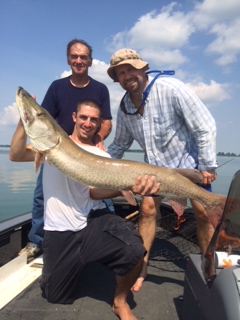|
|
Posts: 455
| Apparently the NJDFGW is considering stocking less but bigger fish. Rather than stock lakes with thousands of 10" to 12" fish they can hold over fish to the 20"+ size and only stock a few hundred. The fishing is fine rite now but the hatchery thinks it can save space and money by stocking the larger fish. Our club president is pretty excited about the news. I think it`s a good idea because years ago our Muskie lakes had no Walleye but now they are choked full of 8lbers that could potentially eat 10" fingerlings. This is the one place in the world Muskie anglers have been complaining about Walleyes eating Muskies lol. Maybe the fishing will improve? |
|
| |
|
Posts: 455
| So what would you prefer 1500 10" or 500 20" ? |
|
| |
|
Posts: 72
| 500 20 inchers for sure. |
|
| |
|

Posts: 483
Location: NE PA | I think the probability of the 500 20" making it to maturity is exponentially better than the smaller fish. I wish the PFBC would stock 10" or larger fish. Last year we stocked 5-6" fingerlings, and I'm not sure how many will make it.
Edited by lennyg3 3/5/2014 9:22 PM
|
|
| |
|
Posts: 994
Location: Minnesota: where it's tough to be a sportsfan! | I really see this as an economic question. The cost to raise them to the 20" size is up there per fish. I think most of us would agree that a continual (over several years) stocking program is allot better ratio for successful populations. The larger they are when stocked the better chance they have of reaching adult size for sure. My personal wish is when they look at a body of water for stocking they look at a 3-5 year term min. Would love to see 5-10 planning on stocking. This would get the population to a point of year class ability from natural spawning. Given each body of water is unique. |
|
| |
|
Posts: 833
| Are there any stats on the survivability of the larger yearlings?
I get the intuitive aspect of it, ie a bigger fish has fewer predators, just wondering if there is data to help support a decision in one direction vs. the other. I know in MN they are moving towards advanced yearlings, ie larger fish to stock in lower quanitities. So the question is what is the cost disparity? |
|
| |
|
Posts: 209
| some of the biologists I have talked to that monitor many year classes of stockings of various sizes have told me they "feel" like about 30% of the 10-12" fingerlings make it to adulthood (30"), and that about 75% of the 20" super fish make it to 30".
No study done here...... just what they see when shocking/netting over the last 15 years. Those 20" fish seem to show up everywhere... I guess the question is what costs more? Stocking 3x the 10"ers or feeding them until they are 20" to get "approximately" the same # of adults? |
|
| |
|
Posts: 833
| That is exactly my thought. Of course there are other issues, ie what is the survivabiltiy at the hatchery, etc. It all comes down to costs. My basic opinion is I want whatever is best for the fishery, but that will always be constrained by whatever reasources are available. It would be interesting to see more data on this topic.
A sidebar in MN is that we are seeing reduced stocking rates by the DNR. I do not know the cause, but I also haven't asked. (I just crunched the stocking reports.) I have heard/read some opinions that this was due to management plans (ie population density) of various lakes as opposed to budget shortfalls, but I wouldn't rate that information beyond being a rumor at best at this point. I know from converstaions in my chapter of MI that there is a lot of discussion about what the best battle to fight is for the future of MN. More Lakes, more Stocking, higher size limits, etc. If anything it shows that with Musky Fisheries things are far from settled and are constantly evolving.
Please Note: I'm not looking to start a debate on this, just citing what I consider to be some useful information.
Edited by Brad P 2/26/2014 1:49 PM
|
|
| |
|
Posts: 455
| We happen to have some great people working at the hatchery in N.J. They have pond room and Muskies inc. often donates food. Craig the main guy seams to think it will save money as you have to feed 12 inchers too. If you raise less but keep them longer the cost is not that different. Plus we only have a few waters to manage. It`s nothing like MN. Very interesting on survival rate. If that's true things should be good in N.J. for a long time. |
|
| |
|

Location: Grand Rapids, MI | Lots of questions about this because it fascinates me... How long are they going to hold them over, until the following fall or just until spring? I ask because 20" seems like very significant growth for an overwinter fish. Are they keeping them indoors and/or warming the water so they keep growing? |
|
| |
|
Posts: 572
| Iowa stocks muskie in the spring and their muskies aren't close to 20 inches. So, how do they grow 20" muskies to stock?
------
"Iowa muskie diet is dry feed until they reach five inches when it switches to minnows. In October, muskies leave Spirit Lake for the Rathbun hatchery where they will live until spring when they are stocked an 11 to 14-inch fish"
from.......
http://www.iowadnr.gov/DesktopModules/AdvancedArticles/ArticleDetai... |
|
| |
|
Posts: 455
| They keep the in a pond for a year. |
|
| |
|
Posts: 1297
Location: Hayward, Wisconsin | The Muskie's, Inc. Chapter in Hayward stocked 540 overwintered (stocked the following Sept. a year plus from when they were hatched) and now they are showing up all over the place. The same year we put about 70 in LCO and even they showed up from such a small number in a 5000 acre lake! Much harder for the pike to eat 20 inch Kalepp Fish Farm beauties than the normally DNR stocked size! Survival appears to be much better with the advanced yearlings. |
|
| |
|
Posts: 209
| yes - that's how its done in IL, usually a full year later or until they run out of minnows or minnow $$$$, or a super hot summer put them in danger, then they may dump them early. It is estimated that the majority or the fish that don't make it to 30" are eaten by other muskies or LM Bass (large LM Bass are very prevalent in most if not all of out musky waters). 30" is the size that they believe they are "safe" from everything in their environment ..... except us 
This same success ratio applies when clubs buy 20"ers from the MN Musky farm. By far this is the best way to jump start a fishery (IMHO) they just seem to survive better...... and that year class is traceable for the next 6-8 years and will be the majority or your catches in a system. |
|
| |
|

Location: Grand Rapids, MI | OK that makes sense now, they're about 1.5 years old. I would be interested to know more about the ROI on these fish. It gets really expensive feeding minnows especially if the fatheads aren't spawning and the hatchery has to rely completely on trucked minnows. Sure the survival is going to be better but if each fish costs $25 to feed vs. $3 for a 12" fall fingerling which is more cost effective. I guess this makes the most sense if talking just a few waters instead of 30+ that need 50K+ fall fingerlings to stock.
Muskie Bob - 2/26/2014 11:53 PM
Iowa stocks muskie in the spring and their muskies aren't close to 20 inches. So, how do they grow 20" muskies to stock?
------
"Iowa muskie diet is dry feed until they reach five inches when it switches to minnows. In October, muskies leave Spirit Lake for the Rathbun hatchery where they will live until spring when they are stocked an 11 to 14-inch fish"
from.......
http://www.iowadnr.gov/DesktopModules/AdvancedArticles/ArticleDetai...
This is where all of the hatcheries need to share information and successes a little better outside of just the Coolwater meetings they have. When we've hauled Iowa fish over here in late-June/early-July and reared them in our ponds they are 12-15" by the end of October, just amazing growth. Those same fish in the Iowa ponds don't grow as fast, I don't know why but I'm sure between Matt at our hatchery and Donna in IA they could figure it out. No reason to overwinter those fish if they can get them to 14-15" by October/November. Edited by Will Schultz 2/27/2014 3:26 PM
|
|
| |
|
Posts: 455
| They make so many fish they don`t know what to do with them now. Any extra fingerlings go in the Delaware river. They have one three hundred acre lake used just for Leech lake strain and the other fish are a hodge podge of genetics from all over the place. Less muskie fishing acreage than one big MN lake in N.J. I think they need the inside space for other fish as well so that may be a consideration. To be honest 20" will be the minimum size holdover. I don`t think it will lead to bigger fish though. I tried to explain to our MI president that the waters and fish life span are the same. The fishing may be better overall but I doubt the ultimate size potential will change. Hope I`m wrong. |
|
| |
|
Posts: 455
| I just wish N.J. could branch out and try obtaining some new genetics to try out. Some southern silvers or some Great lakes. Would be interesting to see the difference in ultimate size. I`m sure it`s not so easy to obtain and raise those fish. To separate them and all that would be a lot of work. We can`t complain though I bet people in other states would be stoked to see 20" + fish being stocked. |
|
| |
|

Posts: 285
Location: NE Wisconsin | I also, like the stocking of 20" muskies. I have seen the success of few of these larger fish stocked into Green Bay each year, with great survival. But as I see it there are a couple of problems. 1) The politicians in charge, like to see larger number of stocked fish in the papers. Quantity vs quality. 2) to raise 20" fish, the ponds are used for 2 years rather then one. You can raise twice as many yearly fish in the same pond. 3) The cost of disease free bait fish is HIGH.
All said, if I owned a lake, I would only stock, 1.5 year old fish. Sept. Oct. |
|
| |
|
Posts: 50
Location: North Central PA | I work at a lake where the PFBC come in and stock from 8-10,000 fingerlings almost yearly. Had the opportunity to witness the stocking several times and the fish are usually tiger hybrid/spotted musky 50-50. They always try to stock them near a large weed bed. As they pipe the hybrids into the lake they almost disappear before your eyes as they rush for cover but when they stock the spotted they sit like a giant pod of freshly stocked trout and the driver dons his boots and drives them as best he can into the weeds. You can see these fingerlings milling around for days and watch the swirls of predatory species probably filling their gullets along with the cormorants and sea gulls. Talking to any of the fishermen on the lake that catch muskies and the ratio is probably 20-1 tigers to spotted in their catch census. Now I feel the numbers of Musky in the lake is good for fishing purposes and maybe the spotted are harder to come by but this is what I witness first hand. Last year they brought in a truckload of fingerlings that were slightly larger...maybe 8-10 that were kept at the hatchery longer but the scenario in the water didn't seem much different. I know nothing I am sating is based on biological research, just some guys observations. Below is some pics of the lil' guys.
[IMG]http://i174.photobucket.com/albums/w90/walk-n-stk/muskyfingerlings002_zpsd90538f0.jpg[/IMG]
[IMG]http://i174.photobucket.com/albums/w90/walk-n-stk/latsmuskies002_zps4120ac83.jpg[/IMG] |
|
| |
|

Posts: 20265
Location: oswego, il | Illinois does not overwinter muskies. We have asked and it's cost prohibitive. They stock them in the fall in their first year at the 10-13" mark. Anyone who goes to an IMA meeting and meets with the DNR knows this. |
|
| |
|
Posts: 455
| Can`t wait to help stock them! |
|
| |
|

Posts: 483
Location: NE PA | Walking stick, what lake are you referring to? Could you pm me? |
|
| |
|
Posts: 209
| Todd - you are correct - IL does not do it as a regular practice because of cost, but it has been done and I was speaking to the success rates when it was done. |
|
| |
|

Posts: 20265
Location: oswego, il | I wish it was done. It gets brought up at the musky show IMA meeting almost every year with the fox chain drawdown and the weed cover lacking and the DNR says just don't have the money for it. |
|
| |
|
Posts: 209
| hopefully you got to experience the fishing 5-8 years after the super fish were added in various systems in various years, it was crazy.............. we are back to "normal" now, wish we could raise enough money for minnows each year to make it feasible again (or to purchase super fish) |
|
| |
|
Posts: 455
| Just saw a picture posted on the MI 22 website. The Leech lake strain fish are at 10" and the food was bought by MI so that's why they can hold them. Says will be stocked next spring. So however big they can in the next year. |
|
| |
|
Posts: 583
Location: deephaven mn | West metro DNR Minneapolis has a study going on right now. There are three lakes involved and three years of stocking of 1.5 year olds and standard .5 year old at three to one ratio (three.5s to one 1.5)to find out if it is cost beneficial to stock
1.5 year olds. the thought is that it is with high pike numbers in these lakes . all the fish have been tagged, but there is not enough data yet to make an assessment, as they are counting on anglers to report catches of tagged fish. fish are starting to be caught, just need more data as these fish grow large enough to be caught and registered |
|
| |
|
Posts: 455
| Not sure if they are marking the fish or doing any kind of comparison in N.J. Think they just kind of assume the survival rate will much improved so less fish need to be stocked. Will be interesting to hear the results of the MN study to confirm that. |
|
| |
 Stocking Size?
Stocking Size? Stocking Size?
Stocking Size?